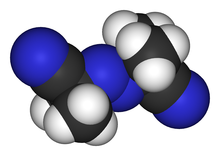| Revision as of 05:08, 28 April 2012 edit117.193.4.5 (talk)No edit summary← Previous edit | Revision as of 14:56, 8 May 2012 edit undo131.211.187.6 (talk) →SafetyNext edit → | ||
| Line 54: | Line 54: | ||
| ==Safety== | ==Safety== | ||
| AIBN is safer to use than ] (another ]) because the risk of explosion is far less. However, it is considered |
AIBN is safer to use than ] (another ]) because the risk of explosion is far less. However, it is still considered as an explosive compounds, decomposing above 64 °C. | ||
| It is soluble in methanol and |
It is soluble in methanol, ethanol and most common organic solvents, but is insoluble in water. A respirator dust mask, protective gloves, & safety glasses should be worn when handling AIBN. | ||
| AIBN is highly toxic. A respirator/dust mask, protective gloves, & safety glasses should be worn when handling AIBN. | |||
| Several water-soluble azo initiators similar to AIBN are manufactured by ]<ref></ref> and Wako.<ref></ref> | Several water-soluble azo initiators similar to AIBN are manufactured by ]<ref></ref> and Wako.<ref></ref> | ||
Revision as of 14:56, 8 May 2012
 | |
 | |
| Names | |
|---|---|
| IUPAC name 2,2′-Azobis(2-methylpropionitrile), 2-(azo(1-cyano-1-methylethyl))-2-methylpropane nitrile | |
| Other names
Azobisisobutyronitrile Azobisisobutylonitrile AIBN | |
| Identifiers | |
| CAS Number | |
| 3D model (JSmol) | |
| Abbreviations | AIBN |
| ChemSpider | |
| ECHA InfoCard | 100.001.030 |
| PubChem CID | |
| CompTox Dashboard (EPA) | |
InChI
| |
SMILES
| |
| Properties | |
| Chemical formula | C8H12N4 |
| Molar mass | 164.21 g/mol |
| Appearance | white crystalline |
| Density | 1.1 g cm |
| Except where otherwise noted, data are given for materials in their standard state (at 25 °C , 100 kPa).
| |
Azobisisobutyronitrile is a compound often used as a foamer in plastics and rubber and as a radical initiator. It is commonly known as AIBN. Its most common chemical reaction is one of decomposition, eliminating a molecule of nitrogen gas to form two 2-cyanoprop-2-yl radicals:
These radicals can be used to initiate free radical polymerizations and other radical reactions. For instance a mixture of styrene and maleic anhydride in toluene will react if heated, forming the polystyrene polymer, only very slowly unless an initiator such an AIBN is present. Another example of a radical reaction that can be initiated by AIBN is the anti-Markovnikov hydrohalogenation of alkenes.
Safety
AIBN is safer to use than benzoyl peroxide (another radical initiator) because the risk of explosion is far less. However, it is still considered as an explosive compounds, decomposing above 64 °C. It is soluble in methanol, ethanol and most common organic solvents, but is insoluble in water. A respirator dust mask, protective gloves, & safety glasses should be worn when handling AIBN.
Several water-soluble azo initiators similar to AIBN are manufactured by DuPont and Wako.
See also
- 1,1'-Azobis(cyclohexanecarbonitrile) or ABCN is another free radical initiator
References
External links
- SIDS Initial Assessment Report for 2,2’-Azobis(2-methylpropionitrile) from the Organisation for Economic Co-operation and Development (OECD)
